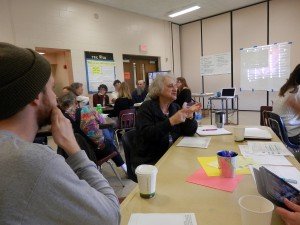Longfellow is leading the way in helping residents think about what climate change will mean to our community.
In November 2016, the City of Minneapolis partnered with the Longfellow and Seward neighborhood associations and Transition Longfellow to host a climate awareness discussion with 20 residents representing a diverse cross-section of the community.
“That was a good start,” said the meeting organizer, Leslie MacKenzie, of Transition Longfellow, “but a lot more people need to be part of this conversation. The problem of extreme weather is going to get worse in the next 5, 10, 15 years. We need to prepare now.”
MacKenzie began to envision a series of talks that would be open to the entire community.
Together with Lisa Strong (Howe), Rachel Hefte (Corcoran), Karen Grabou (Longfellow), Ebony Beck (Hiawatha), Dani Cloutier (Powderhorn), and Eliza Tocher (Cooper), she developed the series: “When Climate Change Comes Home.”
 Paul Moss (photo left, submitted), coordinator the of the Minnesota Pollution Control Agency’s Climate Adaptation Team, was the first speaker at the kick-off event in April, “Climate and Health.“ He shared data from the state climatologist’s office and said “impacts of climate change are already being observed in our state.”
Paul Moss (photo left, submitted), coordinator the of the Minnesota Pollution Control Agency’s Climate Adaptation Team, was the first speaker at the kick-off event in April, “Climate and Health.“ He shared data from the state climatologist’s office and said “impacts of climate change are already being observed in our state.”
Climate change is already to blame for more heavy rainfall events, like the flood in Duluth. The state has seen seven mega-rain events in the last 16 years; the same number that had occurred in the previous 130 years. Flooding, soil erosion, damaged roadways, polluted groundwater, water and mold in homes; these are just some of the results of extreme rainfall.
While most people associate climate change with heat, Minnesota climate experts see that becoming more of a problem after 2025. What Minnesota is experiencing now is warming winters (think icy sidewalks and freeze-thaw damage to roadways).
“Gardeners might be excited by the idea of an earlier spring and a longer growing season,” said MacKenzie. “Unfortunately, what we are really experiencing is more variability. Fifty-degree days in February, then plunging back to zero. Plants and animals have a hard time dealing with that.”
At the April event, Lisa Strong shared information from the Minnesota Department of Health about the health impacts of climate change, from air quality issues and longer allergy seasons, to water-borne and insect-borne diseases.
 Photo right: Neighbors gathered in April to discuss "Climate and Health." Four more talks are planned. (Photo submitted)
Photo right: Neighbors gathered in April to discuss "Climate and Health." Four more talks are planned. (Photo submitted)
“This series is an opportunity for residents to learn more so they know what to do in case of emergency,” said MacKenzie. “But realistically, we can’t do everything as individuals. We also need to think about what we can do together as a community. What are our community assets? What resources can be shared? What resources are we lacking?”
It’s not just infrastructure that is at risk. “Do you know which of your neighbors may need help because of age or disability? If flooding damages homes, where can homeowners get help? Do we have a community emergency fund? Or is everyone left to figure it out for themselves, with the possibility that some homes become unlivable?” MacKenzie said.
“At our first meeting, we had 25 people participate. We captured their feedback, and at each session, we will gather more input to use to develop a community action plan.
“Can the neighborhood association set aside some of its funds for community preparedness education, for emergency assistance or basement waterproofing? What about the city? We have never talked about it before at the community level.” said MacKenzie.
According to follow up communication from Moss, “Although a number of Minnesota communities are starting to prepare for the impacts of climate change, much work yet needs to be done… Longfellow’s work promises to pay important dividends in a more resilient neighborhood in the years ahead.”
Moss has characterized the “Climate Change Comes Home” project as “groundbreaking work that can serve as a model for other Minnesota communities.” But the promise of this project depends upon community participation.
“It’s the depth and diversity of the conversation that will bring new and effective ideas for working together as a community,” said MacKenzie. “We’re talking about resilience here; about being able to bounce back from challenges. That doesn’t happen by accident.”
There are four more talks in the “When Climate Change Comes Home” series:
• Thur., June 15, 6:30–9pm – “Severe Storms and Power,” at Longfellow Park, 3435 36th Ave. S. June speakers include Casidy Anderson, Community Risk Reduction Officer with the Minneapolis Fire Department, Dave Crawford, a naturalist with the DNR, and Bruce Stahlberg, Affordable Energy Solutions. After the speakers, community members will brainstorm actions they can take to be personally prepared and what people can do together to build a more caring, climate-ready community. This series is co-sponsored by the Environm ent Committee of LCC.
ent Committee of LCC.
• Thur., July 20 – “Heat Waves”
• Thur., Sept. 21 – “Insect- and water-borne diseases”
• October – “Putting the Pieces Together in a Community Action Plan”
The group is also working with the City of Minneapolis to host an emergency preparedness Ready Camp for neighborhood residents, including families with children. To learn more, visit the Transition Longfellow website at www.Transitionlongfellow.org. This speaker series is cosponsored by the Environment Committee of the Longfellow Community Council.
Comments
No comments on this item Please log in to comment by clicking here